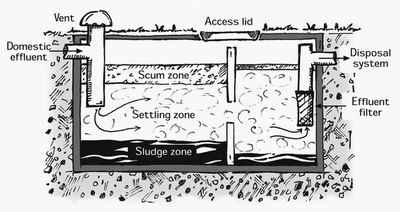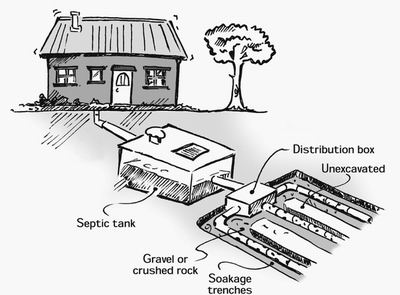Septic tanks
Septic tanks prevent the suspended solids in household effluent from entering the disposal system. The escape of excessive suspended solids from a septic tank causes clogging of the disposal system and is the most common cause of early failure.
Three main processes take place in the septic tank:
- The heavier, solid particles settle to the bottom of the tank forming a sludge layer.
- Lighter materials such as fat and grease float to the surface forming a scum layer.
- Within the septic tank there is little or no oxygen, and anaerobic bacteria (bugs that can live without oxygen) break down some of the solids. This helps to reduce the build-up of sludge in the tank.
The effluent that leaves a well operating septic tank contains only the smaller particles that are less likely to rapidly clog the disposal system.
 The diagram shows a “standard” septic tank design. More sophisticated designs may be required for heavy load conditions and/or sites with poor soakage or other disposal constraints. Advice on these can be obtained from a qualified professional.
The diagram shows a “standard” septic tank design. More sophisticated designs may be required for heavy load conditions and/or sites with poor soakage or other disposal constraints. Advice on these can be obtained from a qualified professional.
Effluent filters
An effluent filter installed on your septic tank outlet will allow only the smaller solids to enter your disposal system. This is a relatively cheap way to significantly reduce the possibility of the early failure of your disposal system.
Most modern septic tanks should have an effluent filter installed on their outlet. With very little modification, effluent filters can also be installed on the outlets of older septic tanks.
Effluent disposal
When the effluent leaves the septic tank, it is only partially treated. The natural processes occurring within the soils below the disposal system carry out the final treatment of the effluent. The type and size of the disposal system used is normally determined by the site conditions, ground water level and soil type. The following types of effluent disposal systems are most commonly used with septic tanks.
Soakage trench and bed systems
These are the most common type of effluent disposal systems used in association with a septic tank.
Perforated pipes (or in older systems field tiles) are laid in shallow trenches filled with gravel. Effluent flows out of the holes in the pipe and soaks into the surrounding soil (see diagram below). Beds are wider and shallower than normal trenches, but should only be used where it is not possible to use trenches.
Every trench or bed system that has more than one pipe for effluent disposal will have a distribution box so that effluent is evenly distributed between each disposal pipe. It is very important that all the outlets from the distribution box to the disposal pipes are at the same level, as even a small difference can result in the failure of a trench or bed due to overloading.
 Soakage trench and bed system.
Soakage trench and bed system.
Some distribution boxes may allow the effluent to be manually diverted from one trench / bed to another. This gives the trench / bed that is not receiving any effluent time to rest (recover) while the other is in use. (See: “Regular Maintenance”).
Evapo-Transpiration Seepage (ETS) Systems
These systems are normally installed where soils have poor soakage. They are similar to soakage trench and bed systems, but are designed to use both soil soakage and selected plants for effluent disposal. This select range of plants must like wet feet as they take up some of the effluent and use the nutrients to grow while the liquid evaporates through their leaves. The disposal area needs to be properly planted to prevent effluent running off during wet periods and causing a problem.
A short list of recommended plants can be found on page 14 of this booklet or phone us on 0800 002 004 to request a full list.
